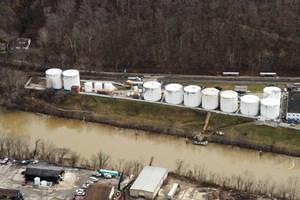Industrial pollutionExtensive corrosion found at chemical tanks of W.Va. site which contaminated region
Investigators by the U.S. Chemical Safety Board (CSB) have reported that they detected significant corrosion in MCHM chemical storage tanks at the Freedom Industries site responsible for a 9 January contamination of the Elk River which has impacted over 300,000 residents of the area.

There is no record of inspection at this West Virginia facility // Source: csb.gov
Investigators by the U.S. Chemical Safety Board (CSB) have reported that they detected significant corrosion in MCHM chemical storage tanks at the Freedom Industries site responsible for a 9 January contamination of the Elk River which has impacted over 300,000 residents of the area.
As theCharleston Gazette reports, the investigators revealed last Wednesday that they still do not know how long “Tank 396” had been leaking, or whether the material had also reached the soil. The leak was originally detected after a citizen reported a “licorice like” odor throughout the area — leading to the thought that 9 January might not have been the first day of contamination.
Johnnie Banks, the leader of the CSB team, told the paper that agency officials “are collecting soil samples and performing additional analysis that might help answer those questions.”
Additionally, the board’s investigation revealed the existence of holes in the tanks to either side of 396. The preliminary report argued that the CSB found “a lack of engineering inspections, and uncertain inspection frequency or rigor of inspections.”
CSB spokeswoman Hilary Cohen said, “To date, we have not found any records of inspection other than those that were developed during the pending purchase of the site in late 2013.”
Further, citing the types of chemicals stored in the tanks, the CSB report urged residents to “continue to distrust information that the water is safe to drink. There is limited toxicological information on MCHM, PPH and the chemical constituents.”
The spill has led to debate between different members of the community, business and investigative organization. There has been criticism of Freedom Industries that it didn’t disclose useful information on the potential health hazards in a timely manner.
Banks, on the other hand, ultimately sees the problem as an infrastructural dilemma, “The obvious question is how this came to be — what was the mechanism of failure for this tank — but on a larger scale, how do you get a situation where you have a chemical plant this close to the intake of a water system that treats water for 300,000 people?”
Deconstruction of the tank has recently begun.